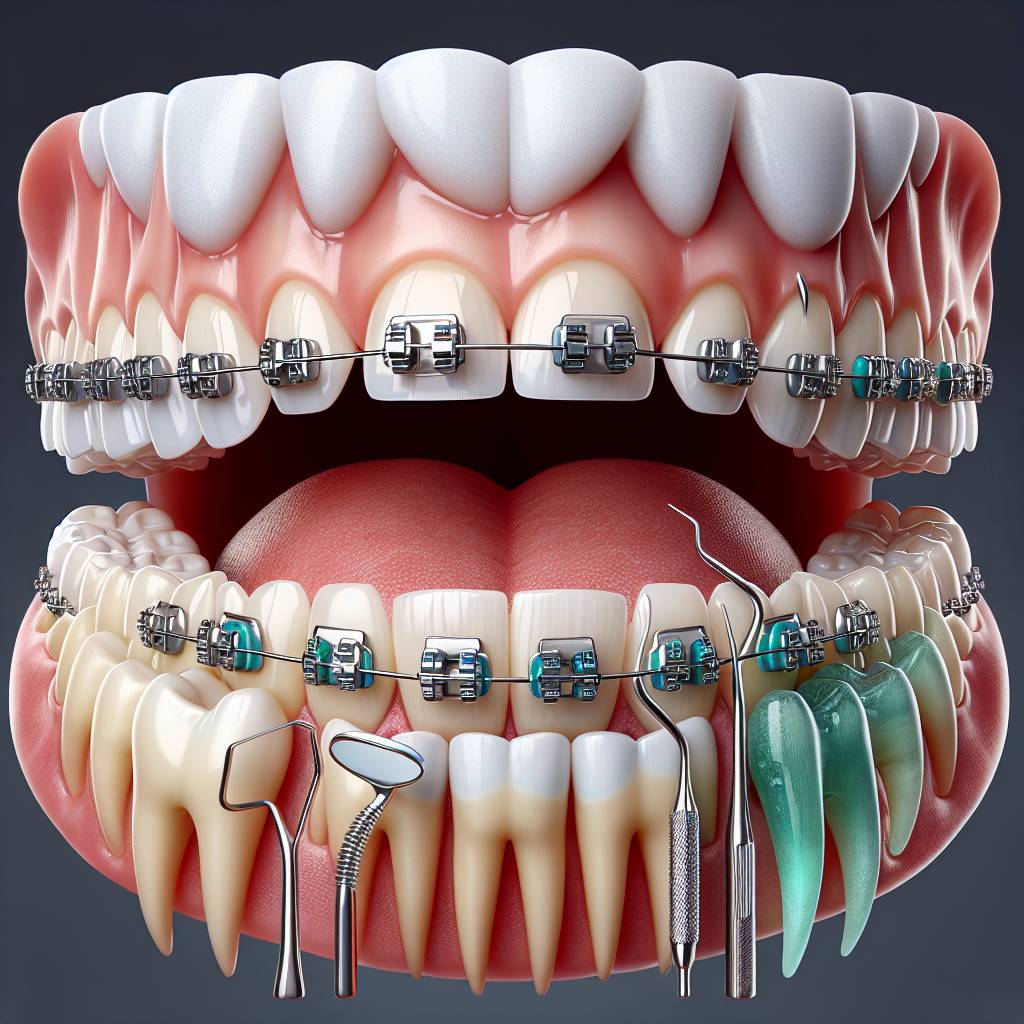Having crooked teeth can be a source of embarrassment and insecurity. Fortunately, there are many options available to straighten your teeth and give you the smile you’ve always wanted. The amount of time it will take to fix crooked teeth depends on the severity of the misalignment, the type of treatment chosen, and how well you adhere to your treatment plan. In this article, we’ll discuss how long it typically takes to fix crooked teeth.The amount of time it takes to correct crooked teeth varies depending on the severity of the misalignment. Generally, braces or other corrective devices can take anywhere from 6 months to 2 years to straighten teeth. In some cases, more complex cases may take longer.
What Factors Affect the Duration of Fixing Crooked Teeth?
The duration of fixing crooked teeth can depend on a variety of factors, including the severity of the misalignment, the age and health of the patient, and the type of treatment chosen. Severity can be determined by an orthodontist during a consultation, and will determine how long it takes to straighten teeth. If teeth are severely misaligned, it may take longer to fix them than if they are only slightly out of place. Age is also an important factor as younger patients tend to respond better to orthodontic treatment than older patients. Health also plays a role in the duration required for fixing crooked teeth, as patients with poor dental hygiene or underlying medical conditions may need more time for their treatment to be successful. Finally, different types of treatments can take varying amounts of time. Braces will generally take longer than Invisalign or other clear aligners, but may be suitable if the misalignment is more severe. Every patient’s situation is unique and will require personalized care from an experienced orthodontist in order to get an accurate estimate of how long it will take to fix crooked teeth.
What Are the Benefits of Fixing Crooked Teeth?
Having crooked teeth can be an aesthetic issue that affects one’s confidence and self-esteem. Fixing crooked teeth can result in a number of benefits, including improved oral health, better self-confidence, and a better ability to eat and speak.
Straightening teeth can help prevent oral health problems in the future. Crooked teeth can be harder to keep clean and free of plaque and bacteria since they are more difficult to brush. This can lead to more cavities, gum disease, and other issues that may require expensive treatment. By straightening the teeth, it is easier to maintain proper hygiene, which will help prevent these issues from occurring in the future.
Having straight teeth can also improve one’s confidence. When people are embarrassed by their crooked or misaligned teeth, it makes them less likely to feel comfortable talking or smiling in public settings. Fixing crooked teeth gives patients the confidence they need to talk and smile without feeling self-conscious about their appearance.
Finally, straightening one’s teeth will improve their ability to eat and speak properly. When a person’s bite is off due to misalignment of the teeth, it can make eating difficult or uncomfortable as well as speaking clearly. By having straight teeth, it is easier for them to chew their food properly as well as pronounce words clearly without having difficulty with certain sounds like sibilants or consonants.
In conclusion, there are many benefits of fixing crooked teeth such as improved oral health, better self-confidence, and a better ability to eat and speak properly. It is important for those considering such a treatment option to speak with their dentist about what options are available for them so they can determine what is best for their particular situation.
Types of Treatment Used to Straighten Crooked Teeth
Straightening crooked teeth is a common concern for many people, as it can have a significant impact on your overall oral health and appearance. Fortunately, there are a variety of treatments available to help you achieve a straighter smile. Some of the most common treatments used to straighten crooked teeth include:
Traditional Braces
Traditional braces are one of the most popular methods for straightening crooked teeth. They use metal brackets and wires to move the teeth into their desired position over time. This treatment typically takes between one and three years, depending on the severity of the misalignment, and requires regular visits to your orthodontist in order to ensure proper adjustment and progress.
Clear Aligners
Clear aligners are an increasingly popular option for those looking for a more discreet way to straighten their teeth. These clear plastic trays fit snugly over your teeth and gradually move them into alignment using gentle pressure. Clear aligners typically take between six months and two years to complete, depending on the severity of your misalignment, and require regular check-ups with your orthodontist.
Dental Veneers
Dental veneers are thin shells that are customized to fit over the front of your teeth in order to give them a straighter appearance. This treatment is usually completed in just one or two visits, but it’s important to keep in mind that veneers are not designed to correct misalignment or improve oral health – they’re simply meant to enhance the look of your smile.
No matter which treatment you choose for straightening your crooked teeth, it’s important that you follow up with regular checkups with your dentist or orthodontist in order to ensure that your new smile is healthy and properly aligned. With the right care and maintenance, you’ll be able enjoy a straighter smile for years to come!
How to Choose a Professional Orthodontist for Fixing Crooked Teeth
Choosing an orthodontist is an important decision that can affect your oral health for years to come, so it’s important to select one that is experienced and qualified. Here are some tips on how to choose an orthodontist for fixing crooked teeth:
1. Research: Do your research and read reviews online about different orthodontists in your area. Look at the qualifications of the staff and their experience in treating complex cases. Make sure that they are board-certified by the American Association of Orthodontists (AAO).
2. Consultation: Schedule a consultation with the orthodontist so you can get a better understanding of their treatment options, fees, and other services they offer. Make sure you feel comfortable talking to them and that they listen to your needs and concerns.
3. Ask Questions: Ask questions during the consultation such as what type of braces they recommend for your case, how long treatment will take, what types of payment plans are available, and any other questions you may have about the procedure or their services.
4. Treatment Plan: Discuss the treatment plan in detail with the orthodontist so you understand exactly what will be involved in treating your crooked teeth. Ask about possible side effects or risks associated with treatment as well as what kind of follow-up care may be necessary after treatment is complete.
5. Follow Up: Schedule regular follow-up visits with the orthodontist after treatment is complete to make sure everything is progressing as planned and that any adjustments are made if needed. You should also discuss any changes in lifestyle or diet that may affect your oral health during this time.
By following these tips, you can find an experienced professional orthodontist who can help you achieve a healthy smile by fixing your crooked teeth safely and effectively.

Common Treatments for Straightening Crooked Teeth
Straightening crooked teeth can be done using a variety of methods. The most common treatments for straightening crooked teeth include traditional metal braces, ceramic braces, lingual braces, and Invisalign.
Traditional metal braces are the most commonly used method for straightening crooked teeth. Metal brackets are attached to the teeth and wires are threaded through them to pull the teeth into alignment. Metal braces are effective but can be uncomfortable and can cause irritation to the soft tissues of the mouth.
Ceramic braces are similar to traditional metal braces in that they use brackets and wires to pull the teeth into alignment. However, instead of metal brackets, ceramic brackets are used which blend in with the color of your teeth making them less noticeable. Ceramic braces are also usually smaller than metal brackets making them more comfortable.
Lingual braces are similar to traditional metal braces except that they are placed on the backside of your teeth making them nearly invisible from the front. Lingual braces use special customized brackets that fit each individual’s teeth perfectly in order to achieve maximum effectiveness and comfortability.
Invisalign is a treatment that uses clear plastic aligners instead of brackets and wires to straighten your teeth over time. The aligners fit snugly over your upper and lower arches of your mouth like a retainer and as you switch out sets of aligners every two weeks, your teeth will gradually shift into place until they reach their desired position.
Possible Risks Involved in Fixing Crooked Teeth
Fixing crooked teeth is a common dental procedure that can help improve a person’s overall appearance. While the risks associated with this type of treatment are generally low, there are some potential risks that should be considered before undergoing the procedure.
One of the most common risks associated with fixing crooked teeth is the possibility of infection. This is especially true if the dentist does not take proper precautions when performing the treatment. Infection can occur if bacteria or other harmful microorganisms enter the mouth during treatment and cause inflammation or even an abscess.
Another potential risk involved in fixing crooked teeth is discomfort or pain. Many people experience some mild pain and discomfort during and after the treatment, which may last for several days. In some cases, people may experience more severe pain that requires additional medication or even surgery to correct. Pain management techniques such as numbing agents or sedation dentistry can help reduce any discomfort associated with the procedure.
The risk of damage to existing teeth is also a concern for those considering this type of dental treatment. If not performed correctly, it’s possible for existing teeth to be damaged during the procedure, resulting in further complications down the road.
Finally, there is also a risk of gum recession after having crooked teeth fixed. This occurs when the gums recede from their normal position, exposing more of the root surface than usual and making it more vulnerable to decay and infection. To prevent this from occurring, dentists will often recommend keeping up with good oral hygiene habits as well as regular dental check-ups after having crooked teeth fixed.
Overall, while there are certain risks involved in fixing crooked teeth, they are usually minor and easily managed by taking proper precautions before and after treatment. It’s important to discuss any concerns you have about these risks with your dentist before beginning any type of dental treatment so that you can make an informed decision about whether or not this procedure is right for you.
Steps to Take Before Fixing Crooked Teeth
Before fixing crooked teeth, it is important for individuals to take a few steps to prepare. First, they should visit a dentist or orthodontist for an evaluation. During this appointment, the dentist will look at the patient’s teeth and evaluate the severity of the misalignment. They will also discuss possible treatment options and any risks associated with them. It is also important for individuals to ask questions about the procedure and its cost, as well as any potential side effects or complications. Additionally, individuals may need to take X-rays or impressions of their teeth in order to better assess their dental situation.
It is also recommended that individuals research different orthodontic treatment options and pricing before making a decision. Additionally, they should discuss any special instructions with their dental professional before beginning treatment so that they can properly care for their teeth during the process.
Steps to Take After Fixing Crooked Teeth
Once crooked teeth have been fixed with braces or other orthodontic treatments, there are a few steps that individuals should take afterwards in order to maintain their new smile. First, they should follow all instructions given by their dental professional regarding diet and oral hygiene practices in order to keep their teeth healthy and strong. Additionally, regular visits with a dentist or orthodontist are important in order to monitor progress and make adjustments when necessary.
Furthermore, patients should not neglect proper oral hygiene habits after treatment has ended since this can lead to plaque buildup which can cause cavities and other dental problems. Lastly, if patients experience any pain or discomfort after the procedure they should contact their dentist immediately in order to get advice on how best to manage it.

Conclusion
Fixing crooked teeth can often be a lengthy process, but it is well worth the effort. While the time frame for treatment can vary depending on the severity of misalignment and the type of treatment chosen, orthodontic treatments are typically completed within 1 to 3 years. In addition, it is important to keep in mind that any orthodontic treatment will also require regular maintenance appointments with an orthodontist.
The success of any orthodontic treatment depends on patient compliance. It is essential to follow all instructions carefully and attend all scheduled appointments in order to ensure that the desired results are achieved in a timely manner. With commitment and dedication, you can enjoy a beautiful smile that will last for many years to come.
If you are considering orthodontic treatment for crooked teeth, it is important to consult with an experienced orthodontist who can evaluate your needs and provide advice on the most appropriate course of action. The orthodontist will be able to provide an estimate of the expected timeline for completion of your treatment so you can plan accordingly.

